PONTIAC GRAND-PRIX 1993 Owners Manual
Manufacturer: PONTIAC, Model Year: 1993, Model line: GRAND-PRIX, Model: PONTIAC GRAND-PRIX 1993Pages: 338, PDF Size: 17.3 MB
Page 191 of 338
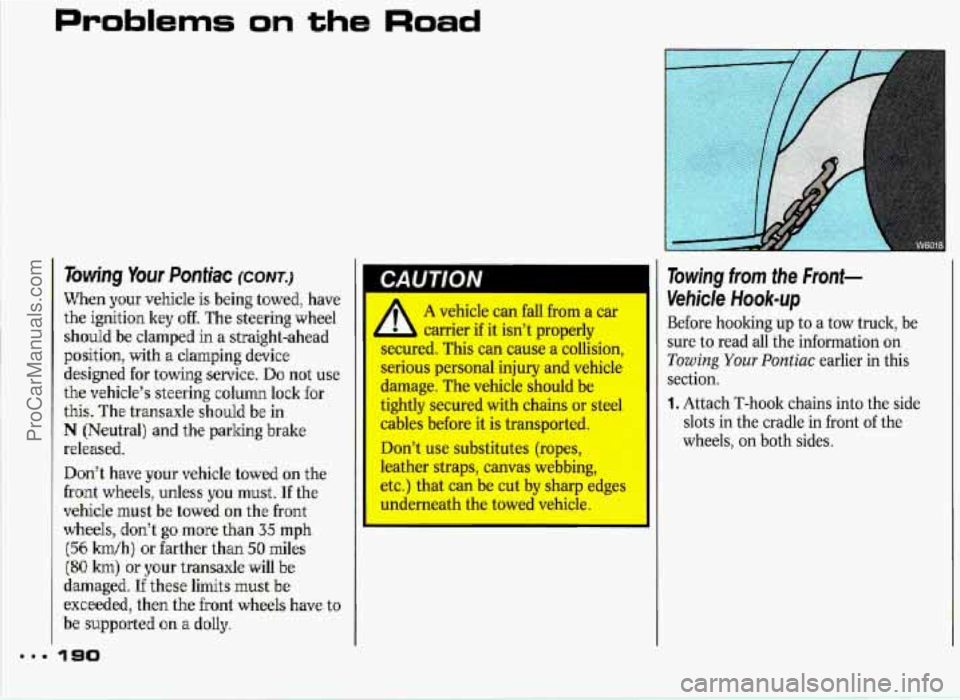
Problems on the Road
Towing Your P onfiac (c0N;T.j
When your vehicle is being towed!, have
the ignition key
off. The steering wheel
should be clamped
in a straight-ahead
position, with a clamping device
designed for
towing service. Do not use
the vehicle's steering
column lock for
this. The transaxle should be in
N [Neutral) and the parking brake
re1,eased.
Don't have your vehicle towed
on the
front wheels, unless
you must. If the
vehicle must be towed
on the front
wheels, don't go more than 35 mph
(56 km/h) or farther than 50 miles
(80 km) or your transaxle will be
damaged. If these limits must be
exceeded, then the front wheels have to
be supported on a dolly.
II
CAUTION
* A vehicle can fall from a car
scb,red. This can cause a collision,
serious personal injury and vehicle
damage. The vehicle should be
tightly secured with chains or steel
cables before it is transported.
Don't use substitutes (ropes,
leather straps, canvas webbing,
etc.) that can be cut
by sharp e('- :s
underneath the tou hicle .
I b carrier if it isn't properly
Towing from the Front-
Vehicle
Hook-up
Before hooking up to a tow truck, be
sure to read all the information on
Towing Your Pontiac earlier in this
section.
1. Attach T-hook chains into the side
slots in the cradle in front of the
wheels, on both sides.
ProCarManuals.com
Page 192 of 338
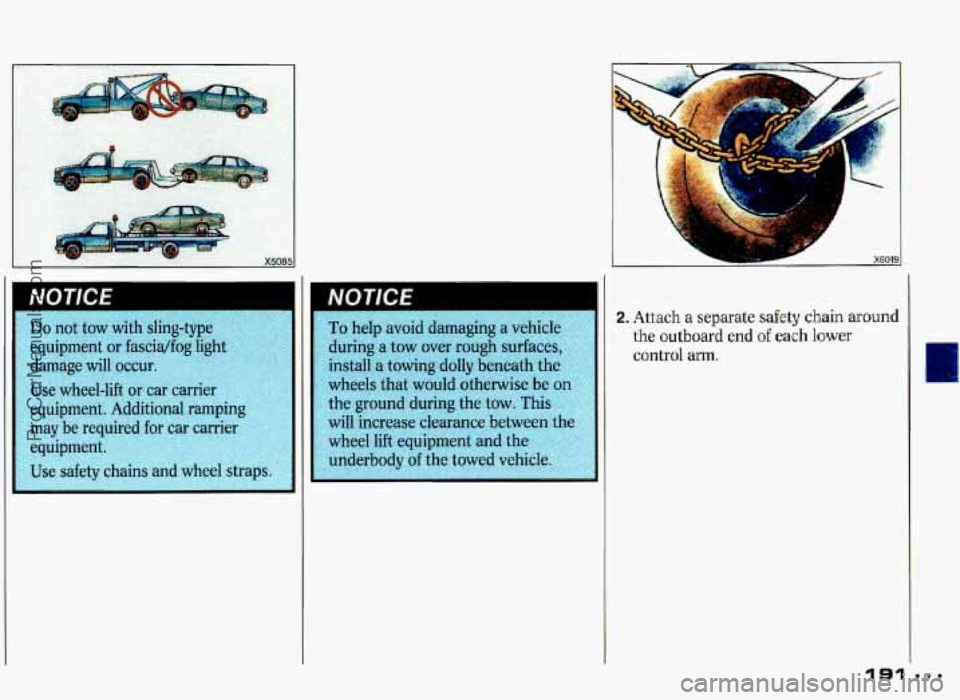
2. Attach a separate safety chain around
the outboard end of each lower
control arm.
r
191 .I.
ProCarManuals.com
Page 193 of 338
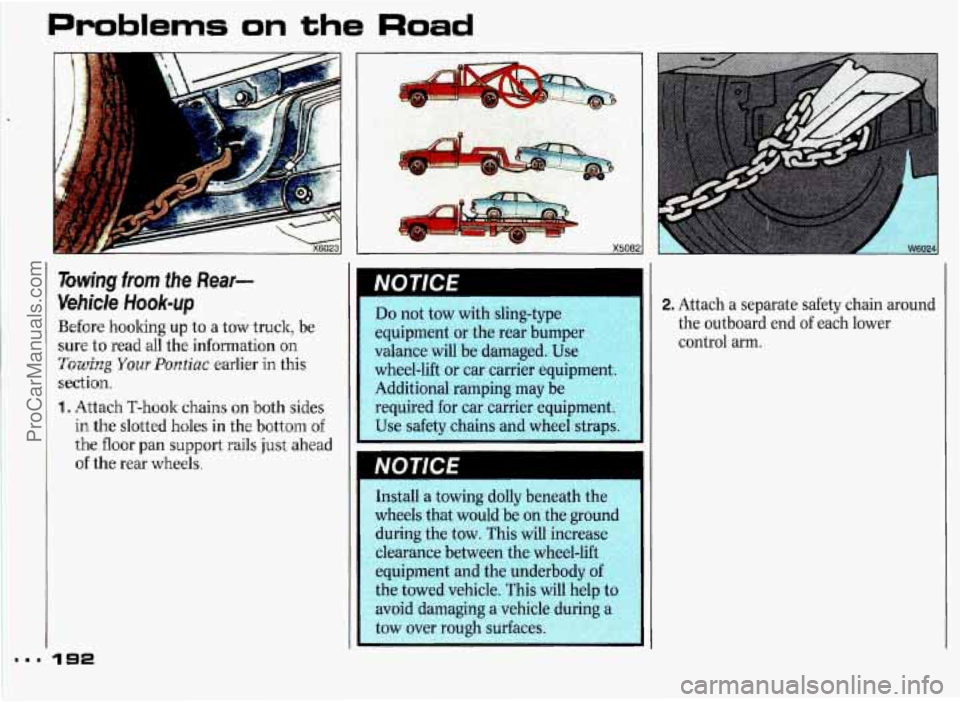
Problems on the Road
1
Towing from the Rear-
Vehicle Hook-up
Before hoolring up to a tow truck, be
sure to read all the information on
Towing Your Polttiac earlier in this
section.
I. ;Qttach T-hook chains on both sides
in the slotted holes in the bottom
of
the floor pan support rails just ahead
of the rear wheels,
X5082
Do not tow with sling-type
equipment or the rear bumper
valance will be damaged. Use
wheel-lift or car carrier equipment.
Additional ramping may be
required for car carrier equipment.
Use safety chains and wheel strans. I
I
Install a towing dolly beneath the
wheels that would be on the ground
during the tow. This will increase
clearance between the wheel-lift
equipment and the underbody of
the towed vehicle. This will help to
avoid damaging a vehicle during a
tow over rough surfaces.
'I
A W6024
2. Attach a separate safety chain around
the outboard end of each lower
control arm.
ProCarManuals.com
Page 194 of 338
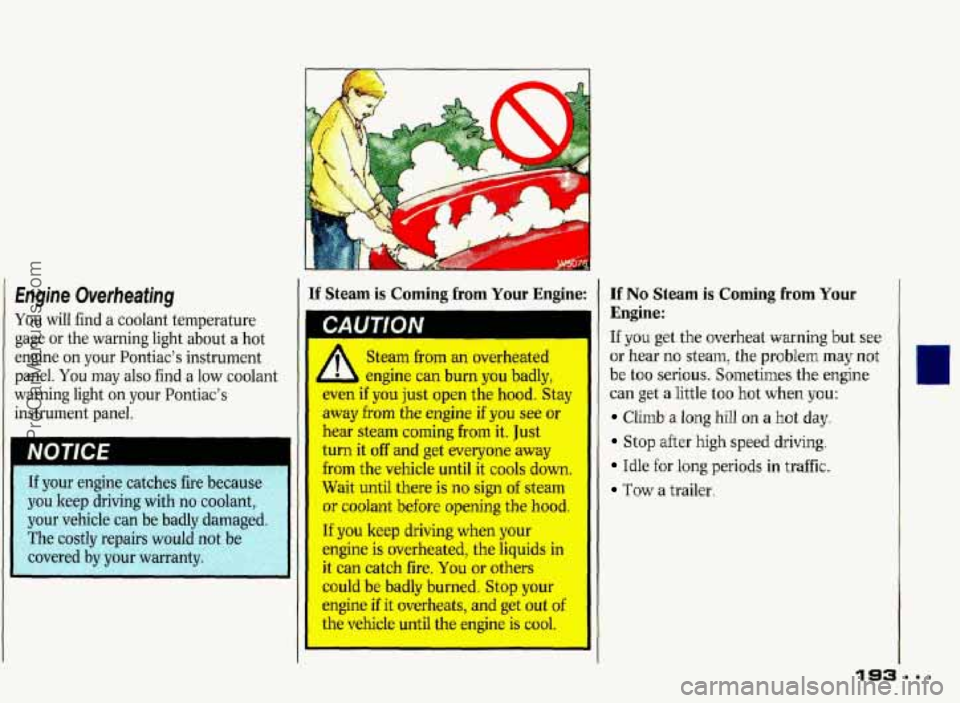
Engine Overheating
You will find a coolant temperature
gage or the warning light about
a hot
engine
on your Pontiac's instrument
panel.
You may also find a low coolant
warning light
on your Pontiac's
instrument panel.
r
If Steam is Coming from Your Engine:
L Steam from an overheated
- b engine can burn you badly,
even if you just open the hood. Stay
away from the engine if you see or
hear steam coming from it. Just
turn it off and get everyone away
from the vehicle until it cools down.
Wait until there is no sign of steam
DP eoolant before opening the hood.
If you keep driving when your
engine is overheated, the liquids in
it can catch fire. YOU or others
could be badly burned. Stop your
engine if it overheats, and get out of
the vehicle until the engine is COOL
1
If No Steam is Coming from Your
Engine:
If you get the overheat warning but see
or hear no steam, the problem may not
be too serious. Sometimes the engine
can get a little too hot when you:
Climb a long hill on a hot day.
Stop after high speed driving.
Idle for long periods in traffic.
Tow a trailer.
-
!
ProCarManuals.com
Page 195 of 338
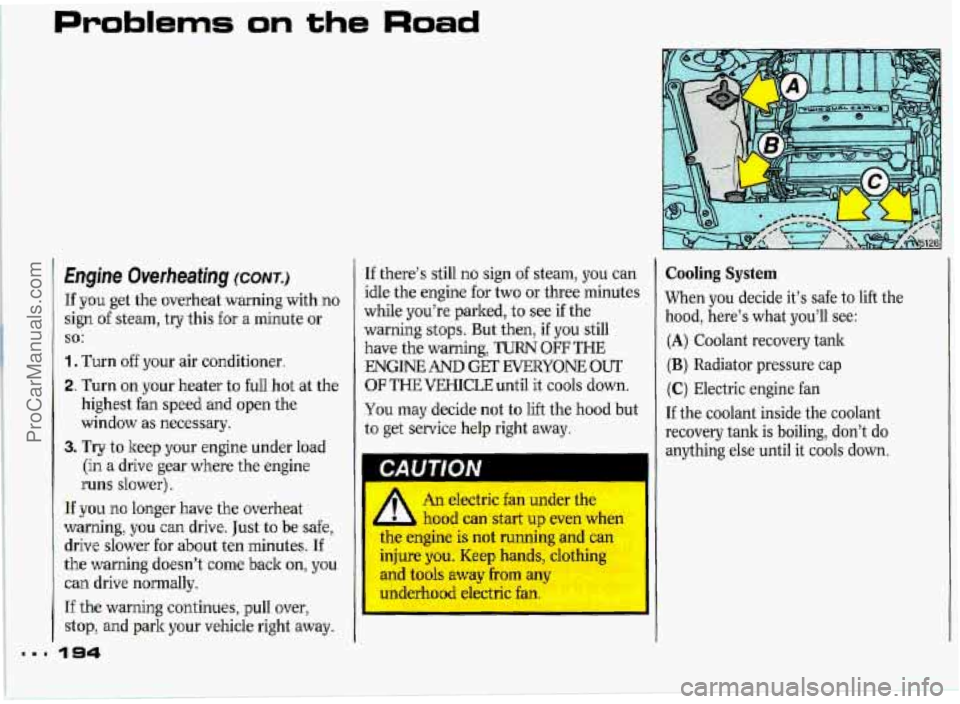
Problems on the Road
Engine Overheafing ICONT.)
If you get the overheat warning with no
sign
of steam, try this for a minute or
1. Turn off your air conditioner.
2. Turn on your heater to full hot at the
SO:
highest fan speed and open the
window as necessary.
3. Try to keep your engine under load
(in a drive gear where the engine
runs slower).
If you no longer have the overheat
warning,
you can drive. Just to be safe,
drive slower for about ten minutes. If
the warning doesn’t come back
on, you
can drive normally.
If the warning continues, pull over, If
there’s still
no sign of steam, you can
idle
the engine for two or three minutes
while you’re parked, to
see if the
warning
stops. But then, if you still
have the warning,
TURN OFF THE
ENGINEANDGETEVERYONEOUT
OF THE IrEp3[1CLE until it cools down.
You may decide not to lift the hood but
to get servioe
help right away.
a
An electric fan under the
L L hood can start up even when
the engine
is not running and can
injure you. Keep hands, clothing
and tools away from any
underhood electric fan. I
stop, and park your vehicle right away. I I
Cooling System
When you decide it’s safe to lift the
hood, here’s what you’ll see:
(A) Coolant recovery tank
(B) Radiator pressure cap
(C) Electric engine fan
If the coolant inside the coolant
recovery tank is boiling, don’t do
anything else until it cools down.
ProCarManuals.com
Page 196 of 338
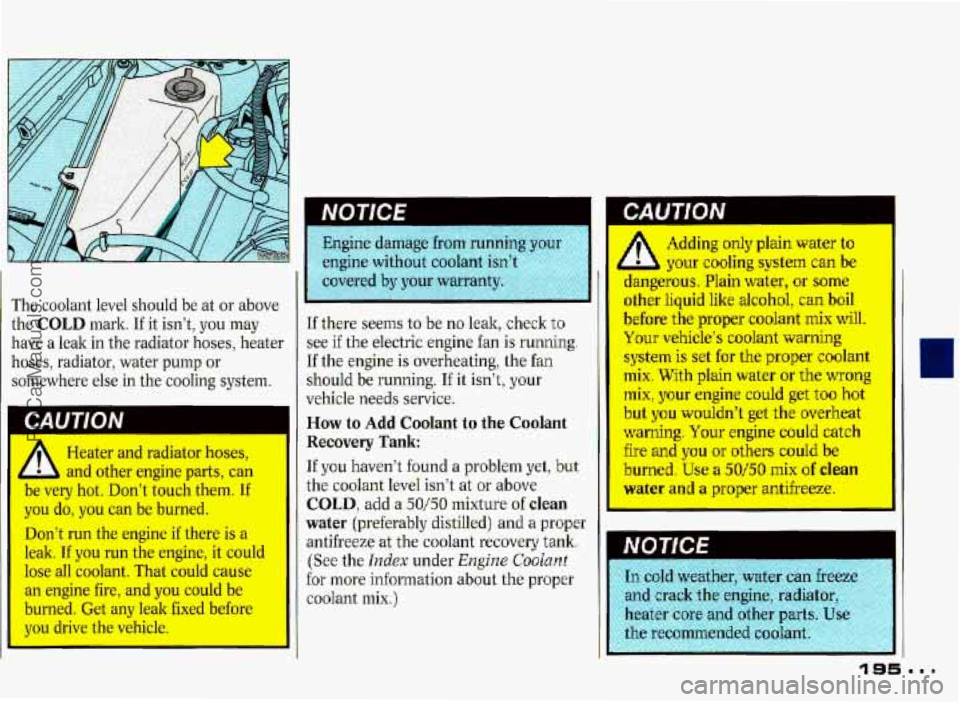
The coolant level should be at or above
the
COLD mark. If it isn’t, you may
have a leak in the radiator hoses, heater
hoses, radiator, water pump or
somewhere else in the cooling system.
~ CAUTION
A
Heater and radiator hoses,
and other
engine parts, can
be very hot. Don’t touch them. If
you do, you can be burned.
Don’$ run the engine if there is a
leak. If you run the engine, it could
lose all coolant. That could cause
an engine fire, and you could be
burned. Get any leak fixed before
I vou drive the vehicle.
If there seems to be no leak, check to
see if the electric engine fan is running.
If the engine is overheating, the fan
should be running. If it isn’t, your
vehicle needs service.
How to Add Coolant to the Coolant
Recovery Tank:
If you haven’t found a problem yet, but
the coolant level isn’t at or above
COLD, add a 50/50 mixture of clean
water (preferably distilled) and a proper
antifreeze at the coolant recovery tank.
(See the
Index under Engine Coolant
for more information about the proper
coolant mix.)
A
Adding only plain water to
your cooling system
can be
dangerous. Plain water,
or some I
other liquid like alcohol, can boil
before the proper coolant
mix will.
Your vehicle’s coolant warning
system
is set for the proper coolant
mix. With plain water or the wrong
mix, your engine could get too hot
but you wouldn’t get the overheat
warning. Your engine could catch
fire and
you or others could be
burned. Use a
50/50 mix of clean
water and a proper antifreeze.
cold weather, water can free-
d crack the engine, radiatnr
ater core and other parts.
ProCarManuals.com
Page 197 of 338
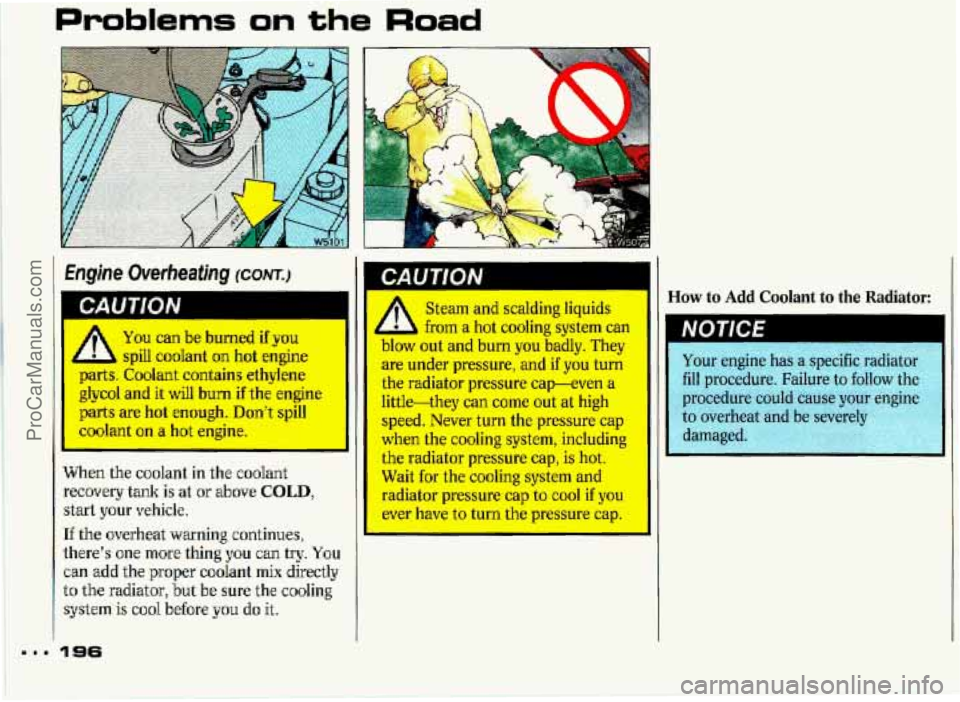
I
Problems on the Road
You can be burned ifp~
l spill coolant on hot engine
parts. Coolant contains ethylene
glycol
and it will bum if the engine
parts are hot enough. Don't spill
coolant on a hat engine.
When the coolant in the coolant
recovery tank
is at or above COLD,
start your vehicle.
If the overheat warning continues,
there's one more
thing you can try. You
can add the proper coolant mix directly
to
the radiator, but be sure the cooling
system is cool before you do it.
'I 96
A Steam and scalding liquids
L from a hot cooling system dm
b.,,v out and burn you badly. They
are under pressure, and if you turn
the radiator pressure cap-even a
little-they can come out at high
speed. Never turn the pressure cap
when the cooling system, including
the radiator pressure cap, is hot.
Wait for the cooling system and
radiator pressure cap tu cool if you
ever have to turn the pressure-cap.
How to Add Coolant to the Radiator:
Your engine has a specific radiator
fill procedure. Failure
to follow the
procedure
could cause your engine
to overheat and be severely
damaged.
ProCarManuals.com
Page 198 of 338
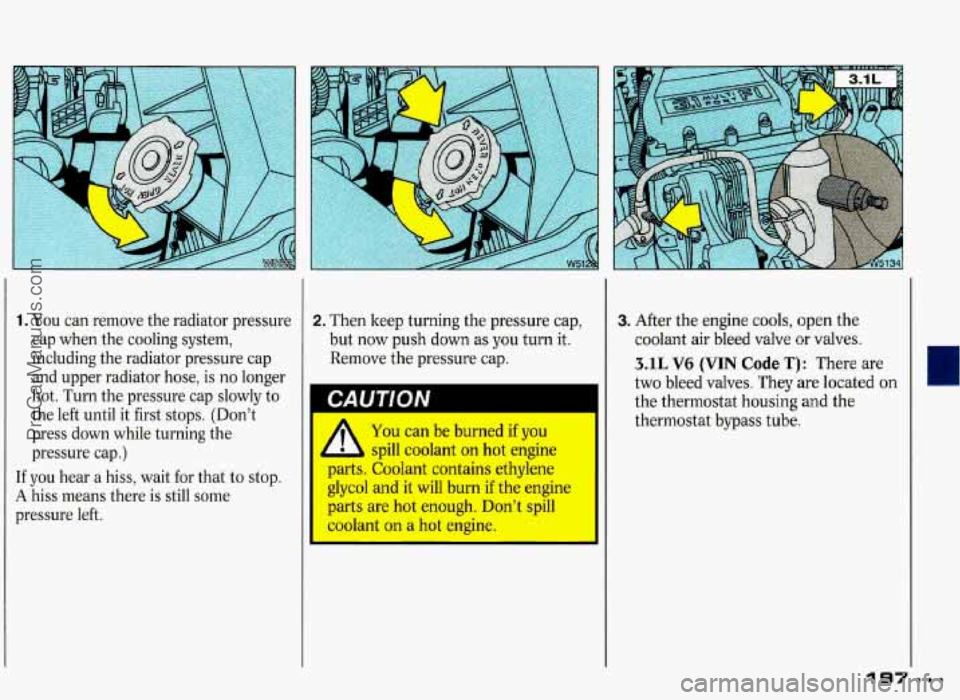
1. You can remove the radiator pressure
cap when the cooling system,
including the radiator pressure cap
and upper radiator hose, is
no longer
hot. Turn the pressure cap slowly to
the left until it first stops. (Don’t
press down while turning the
pressure cap.)
If you hear a hiss, wait for that to stop.
A hiss means there is still some
pressure left.
2. Then keep turning the pressure cap,
but now push down as you turn it.
Remove
the pressure cap.
I CAUTION
I A You can be burned if you
spill
coolant on hot engine
pa La. Coolant contains ethylene
glycol and it will burn if the engine
parts
are hot enough. Don’t spill
coolant on a hot engine.
3. After the engine cools, open the
coolant air bleed valve or valves.
3.1L V6 (VIN Code T): There are
two bleed valves. They
are located on
the thermostat housing and the
thermostat bypass tube.
ProCarManuals.com
Page 199 of 338
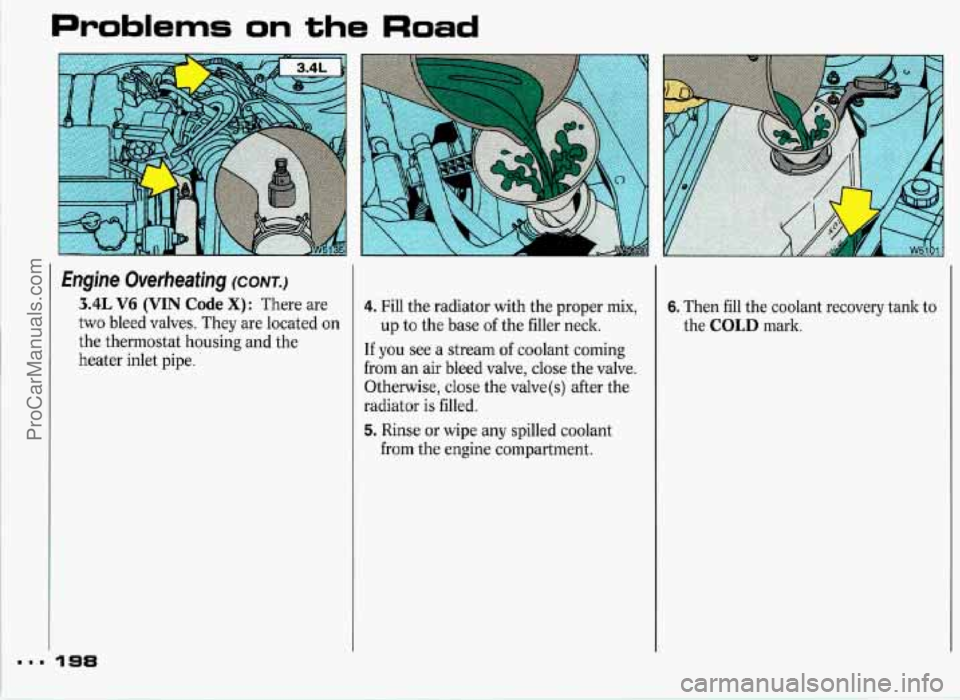
Problems on the Road
I I
~
I..
€ngh Overheating (cow.)
3.4L V6 (VIN Code X): There are
two bleed valves. They are located on
the thermostat housing and the
heater inlet pipe.
1 918
4. Fill the radiator with the proper mix,
up to the base of the filler neck.
If you see a stream of coolant coming
from an air bleed valve, close the valve.
Otherwise, close the valve(s) after the
radiator is filled.
5. Rinse or wipe any spilled coolant
from the engine compartment.
6. Then fill the coolant recovery tank to
the
COLD mark.
ProCarManuals.com
Page 200 of 338
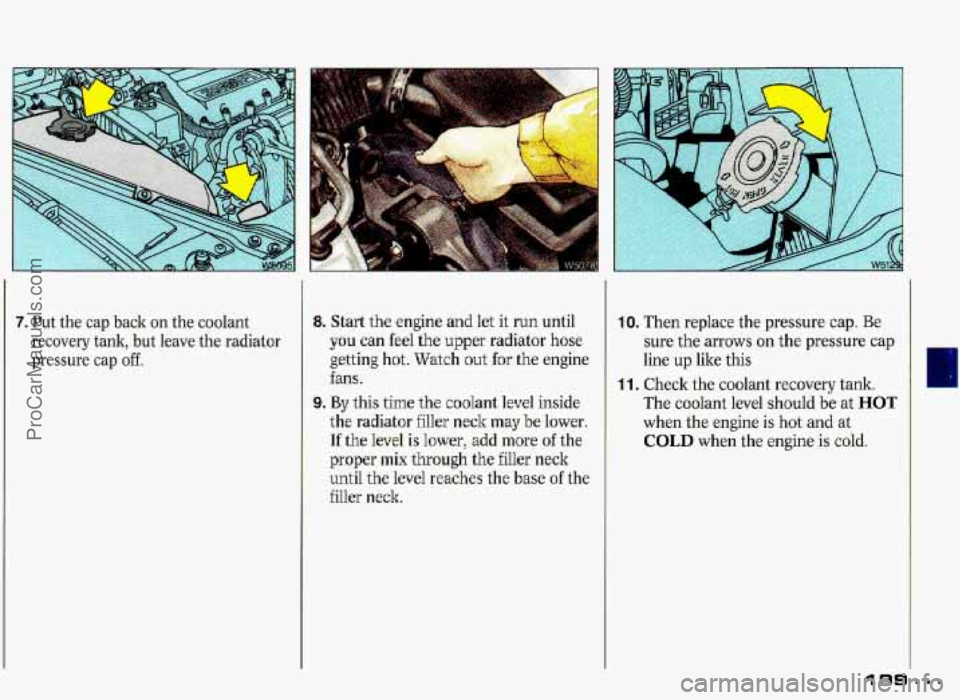
7. Put the cap back on the coolant 8. Start the engine and let it run until
recovery tank, but leave the radiator
you can feel the upper radiator hose
pressure cap off. getting hot.
Watch out for the engine
fans.
9. By this time the coolant level inside
the radiator filler neck
may be lower.
If the level is lower, add more of the
proper
mix through the filler neck
until the level reaches the base of the
filler neck.
10. Then replace the pressure cap. Be
sure the arrows
on the pressure cap ~
line up like this
11. Check the coolant recovery tank.
The coolant level should be at
HOT
when the engine is hot and at
COLD when the engine is cold.
ISS...
ProCarManuals.com